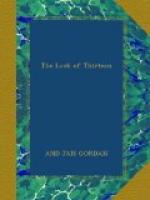We crept to its gateway and through a crack saw visions of a romantic courtyard. The gate was locked, and we asked a little shoemaker—
“Who has the key?”
“It is now a leather tannery,” he answered, and directed us to a shoemaker in another street. This was full of shoemakers, and we chased the key from shop to shop. It was like “Hunt the slipper.” At last we ran it to earth in the second waistcoat of a negligent individual in a fez.
How happy the merchant of old must have felt when he entered the courtyard after a long journey! The court was big and square, with a fountain in the centre, the pillars were blue, and the arches red. Tiers upon tiers of little rooms were built around; the expensive ones had windows and the cheap ones none, and the door of each was marked by the smoke of a thousand fires which had been lit within. Underneath were cubby holes for the merchants’ goods, and behind it all was a great dark stable for the animals. Once shut up in the caravanserai one was safe from robbers, revolutions, and the outside world. Lying in the doorway, as if cast there by some gigantic ogre in a fit of temper, were two immense marble vases, and two queer carved stone figures. Who made these figures? Mystery—for Turkey does not carve. The old caravanserai no longer gives protection to the harassed traveller, it only cures his boots, for it has fallen from sanctuary to shoemakers, and the leather workers of Uskub cure their hides therein. Hence, despite its beauty, we did not loiter long, for we have ever held a bad smell more powerful than a beautiful view.
Why don’t towns look tragic when their bricks reek of tragedy? Why is industrial misery the only form in which the cry of the oppressed is allowed to take visible shape and to make the reputation of Realist artists? In Uskub is concentrated the whole problem of the Balkans and of Macedonia. Her brightly painted streets are filled with Serb, Bulgar, and Turk, each disliking the rule of the other, the Bulgar hating the Serb only worse than the Turk because the Serb is master. To the inquiring mind it is problematic how much of this hate is national, and how much political. Deprive these peasant populations of their jealous, land-grabbing propagandist rulers, and what rancour would remain between them? Intensive civilization, such as has been applied to these states—civilization which has swept one class to the twentieth century, while it leaves the others in its primitive simplicity—seems always to produce the worst results. Nations can only crawl to knowledge and to the possessions of riches, for politics to the simple are like “drinks” to the savage and equally deadly in effect.
[Illustration: A WINE MARKET IN USKUB.]




